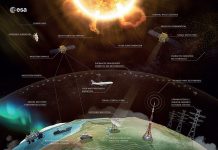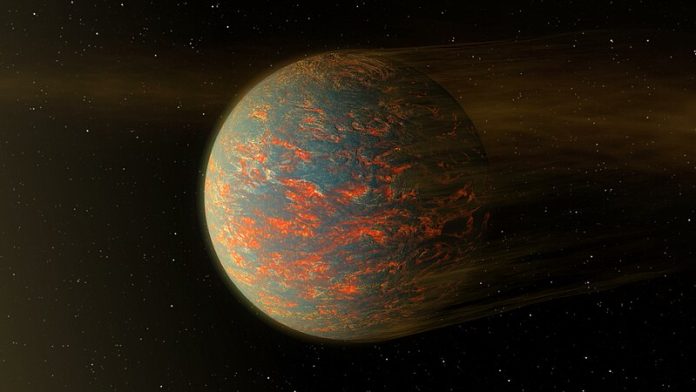A study involving measurements by James Webb Space Telescope (JWST) suggests that the exoplanet 55 Cancri e has a secondary atmosphere outgassed by magma ocean. Instead of vapourised rock, the atmosphere may be rich in CO2 and CO. This is the first instance of detection of secondary atmosphere around a rocky exoplanet and is significant in exoplanet science because acquisition and sustenance of a gas rich atmosphere by a rocky planet is key to habitability.
Exoplanets (i.e., planets outside the solar system) are the foci in the search of signatures of extra-terrestrial life. Detection and characterisation of exoplanets in the stellar systems are important for study of habitable earth-like planets with environment and conditions conducive to support life.
The first exoplanets were detected in the 1990s. Since then, over 5000 exoplanets have been discovered in the past few decades. Nearly all of them were found in our home galaxy Milky Way. An exoplanet in an external galaxy was discovered for the first time in 2021.
Exoplanets with rocky terrain and secondary atmosphere are of special interest to the astronomers because such exoplanets are likely to have earth-like conditions. Secondary atmosphere is formed from outgassing of materials trapped in warm mantle to the surface of the planet. For terrestrial planets, primary atmosphere formed of light gases such as hydrogen and helium accreted during initial formation of the planet is lost due to lower surface temperature and escape velocity of the planet.
The Exoplanet 55 Cancri e
The Exoplanet 55 Cancri e is a hot rocky exoplanet situated 41 light-years away from Earth in the constellation Cancer. Predominantly rocky with an equilibrium temperature of around 2,000 K, it orbits the Sun-like star 55 Cancri and is classified as a super-Earth (because it has a diameter twice that of Earth and density slightly greater). Its composition is likely to be similar to rocky planets in the solar system.
Previous studies of this exoplanet suggested presence of an atmosphere rich in volatiles. Results disfavoured presence of H2/He-dominated primary atmosphere but it could not rule out the possibility that the gas envelop is made of vapourised rock as the planet is hot enough to allow evaporation of molten rocks. It could not be known whether the atmosphere of this e exoplanet is secondary formed from outgassing of materials trapped in warm mantle to the surface of the planet.
Secondary atmosphere develops after primordial lighter gasses (mainly H2 and He) are lost as the planet cools. It is formed from outgassing from interior to the surface of the planet due to volcanoes or tectonic activities. For example, the atmospheres of Venus, Earth and Mars are secondary atmosphere. Prescence of secondary atmosphere in an exoplanet is suggestive of further evolution of an early-stage planet towards possible habitability.
JWST investigation of exoplanet 55 Cancri e
The thermal emission spectrum measurements of the exoplanet 55 Cancri e by the instruments aboard James Webb Space Telescope (JWST) has ruled out the possibility of atmosphere being made of vapourised rock. The new findings indicate that the atmosphere is outgassed from a magma ocean and is probably rich in CO2 and CO.
This is a significant development in exoplanet science. This is the first time that an exoplanet is detected to have a surrounding atmosphere formed from outgassed materials from the interior (a secondary atmosphere).
Earth, Venus and Mars in our solar system were covered with the magma ocean in the past with an interplay of atmosphere, surface and interior. Hence the new development could help us better understand the early conditions of Earth, Venus, and Mars and how a rocky planet acquires and sustains a gas-rich atmosphere, a key requirement for a planet to be habitable.
***
References:
- JPL. Exoplanets – NASA’s Webb Hints at Possible Atmosphere Surrounding Rocky Exoplanet. Posted 8 May 2024. Available at https://www.jpl.nasa.gov/news/nasas-webb-hints-at-possible-atmosphere-surrounding-rocky-exoplanet
- Hu, R., et al 2024. A secondary atmosphere on the rocky exoplanet 55 Cancri e. Nature 630, 609–612. Published: 08 May 2024. DOI: https://doi.org/10.1038/s41586-024-07432-x
- University of Oregon. Pages – Primary and secondary atmosphere. Available at https://pages.uoregon.edu/jschombe/ast121/lectures/lec14.html
***




































